
| Plug Flow Reactors for Viscous Material Polymerization Tubular reactors filled with static mixing elements are often used as plug flow polymerization reactors for viscous materials. |
|
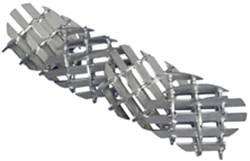 Figure #1: GX static mixer used in plug flow reactors for viscous materials. |
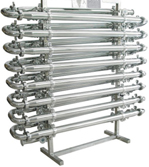 Figure #2: Typical layout of a skid-mounted small diameter long residence time static mixer plug flow reactor.
|
Principles of Operation The typical process goals of a continuous polymerization reactor are that the reaction product be homogeneous with regard to molecular weight, degree of reaction achieved, viscosity, temperature, molecular weight distribution and other chemical and physical properties. For this to be achieved, all the material within the reactor must be well mixed and have the same residence time (plug flow). A tubular reactor is a fundamentally simple continuous reactor where there are no moving parts other than pumps that deliver the reactants. Unfortunately, an empty tube is not suitable as a viscous material chemical tubular reactor. However, the addition of GX static mixing elements inside the tube provides the ideal conditions of radial mixing and near plug flow necessary to perform chemical polymerization reactions. Radial Mixing: |
|
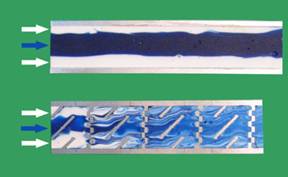 Figure #3: Laminar flow in an empty tube (top) and through a GX static mixer (bottom). |
|
| Plug Flow: In addition to excellent mixing, continuous reactors require plug flow conditions which means that all the material processed through the reactor must have the same residence time. An empty pipe is a poor continuous reactor because the material in the center of the pipe travels at twice the average velocity resulting in poor plug flow characteristics (Figure #4 and #5). Due to poor empty pipe plug flow characteristics, material in the center of the pipe will exit only partially reacted (short residence time) where the first material break-through is at 0.5 of the overall residence time (Figure #5) while material at the wall will still not have exited at 2.5 residence times (Figure #5). The addition of GX static mixing elements in a pipe dramatically improves plug flow characteristics (Figure #4 and #5). |
|
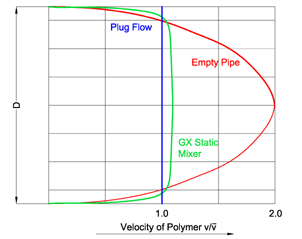 Figure #4: Velocity profile in an empty pipe (red), GX static mixer (green) and Ideal Plug Flow (blue) |
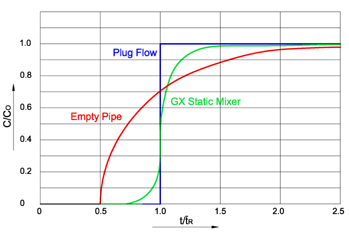 Figure #5: Step Response Curve to a step change at pipe entry for Ideal Plug Flow (blue), GX static mixer (green) and Empty Pipe (red). |
| More Information Technical Bulletin (pdf 97 kb) Customer Specification Questionnaire (Excel 33 kb) |
|
Request A Quote | Mixer Selection Guide | Site Map
Mexico & South America: StaMixCo-Mexico; Geranios 26, J del Alba; C. Izcalli; 54750 Estado de Mexico; Tel: 52 (55) 2876 2311
USA & Canada: StaMixCo LLC; 235-84th Street; Brooklyn, New York 11209 U.S.A.: Tel: (718) 748-4600
Europe, Asia-Pacific, Africa: StaMixCo Technology Ltd.; Ebnetstrasse 8; CH-8474 Dinhard, Switzerland: Tel: +41 52 338 17 11
© 2008 StaMixCo, LLC. | Powered by Register.com